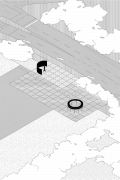One day after the Oktoberfest bombing in September 1980, the then mayor of Munich, Erich Kiesl, said: “Therefore one must also say: Life goes on.” And although life for the victims and those affected naturally did not just continue its course, it retrospectively seems as though this statement had become a sort of guiding principle for the official commemoration efforts: the victims were honoured, a memorial was erected – and yet the remembrance should, above all, not disturb the present (and particularly not the Oktoberfest).
It took 40 years until an invited competition for an information site was set up, to shed more light on the background of the attack and its victims. Besides providing a space for information and reflection, the proposal had to consider the unique conditions of the site: it would have to be designed in a way which discouraged vandalism or abuse by the intoxicated visitors of the Oktoberfest.
We proposed an “information ring” which would continuously keep the existing monument, and thus the site of the bombing, in the visitor’s view. The design is not an autonomous object (neither information pavilion nor memorial stone) but in an active sense a “placeholder”: it marks, makes space and offers room for information and commemoration.
While the form is based on the existing monument, the materiality of the information site refers directly to the urban environment around it: the floor is made of seemingly every day but precisely manufactured precast concrete elements; the information ring is constructed out of powder-coated steel, referring back to the colour and material of the security bollards at the entrance to the fairground; the monitors inside evoke associations with billboards or information screens on public transport.



While the competition had aimed for an information site, it became increasingly clear that what was needed above all, was an emphatic official remembrance and tribute to the victims of the attack. Having ben invited into a revision round, we proposed to create a unifying public space – integrating memorial and information ring – which would provide a dedicated space for remembrance: a “Square for the Victims of the Oktoberfest Bombing”. The name here was not intended as a guiding concept, but actually the proposal in itself. We wanted the square to become an integral part of the urban fabric of streets and squares. Naming as a dedication, remembrance via inscribing the incident on official street maps.






